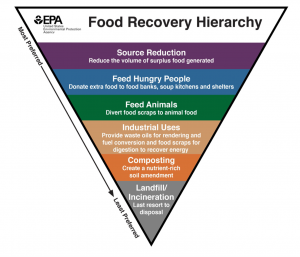Did you know that over one-third of food produced in the U.S. is never eaten? This is a huge problem. This wastes the natural resources and inputs that went into producing that food and increases environmental impact. Food waste is the most common material in landfills and incinerators in the U.S.
Reducing the amount of food wasted at various stages along the food system will help increase food security, efficiency, resource conservation, and productivity, while addressing environmental concerns, such as climate change.

So how do we solve this issue of food waste? The U.S. Environmental Protection Agency provides a guide called the Food Recovery Hierarchy to help prevent and divert food waste. The areas at the top are the most preferred and decrease in preference as you go down the inverted triangle.
The best method of reducing food waste is through source reduction, as this prevents food waste to begin with. We can make sure that we are buying only what we need. This can be done by both businesses and individuals through inventorying supplies and grocery lists.
Source reduction makes sure that we are efficiently using the resources that go into producing food rather than squandering them. This also saves money on both buying and disposal, and labor costs for stocking businesses.
Read More: Food future: What will it take to nourish a nation in 2050?
The second tier is redistributing food to feed hungry people. According to the EPA, in 2018 about 63 million tons of food were wasted in the United States. While at the same time, the U.S. Department of Agriculture estimates that in 2019, 10.5 percent of American households had difficulty providing enough food for their household members due to lack of resources. Much of these millions of tons of food wasted was still wholesome and edible. We can feed people rather than landfills by donating unspoiled food to our neighbors in need. Food pantries, banks, and rescue organizations are located across the country, serving communities in need.
Food pantries and related organizations
• To find a local food bank: Click here
• To find local food rescues: Click here
• Locate nearby food pantries: Click here
• Other organizations: Hunger Free America (to help find food assistance), Food Recovery Network, Food Donation Connection, and Rock and Wrap It Up
The next tier, which is near and dear to the heart of livestock farmers, is to feed animals! Farmers have been doing this for centuries.
Food waste can also be diverted to zoos, pet food, and more! Livestock — especially ruminants such as cattle, sheep, and goats — are the ultimate upcyclers. They take human-inedible byproducts from other industries and food waste and upgrade this into high-quality meat, milk, and fiber. Common byproducts fed to livestock include almond hulls, brewers grains, cotton seeds, soybean meal, bakery waste, cookie and candy meal, peanut meal, ugly produce, and so much more. This helps to enhance the sustainability of animal agriculture and our entire food system!
To learn more about feeding byproducts and food waste to ruminants, check out this Facebook post from “Cow Nerd.”
The next step on the Food Recovery Hierarchy is industrial uses. Food waste also has important uses in renewable energy. Aerobic digestion can transform food waste and even animal manure into biogas and fertilizer. There is also increasing interest in creating biofuels and other products from food waste.
Towards the bottom of the Food Recovery Hierarchy is composting, which can be used to nourish the soil, which in term can grow crops. Compost is beneficial to soil quality, crop yields, water retention, and carbon sequestration.
Landfill and incineration are at the bottom of the Food Recovery Hierarchy, as it is the least valuable method of food waste use. Did you know food waste comprises 24 percent of landfilled solid waste and 22 percent of combusted municipal solid waste?
By source reduction, donating food, feeding animals, industrial uses, and composting, we can help reduce food waste, which will in turn increase food security, productivity, efficiency, and resource conservation while addressing environmental concerns.
Michelle Miller, the Farm Babe, is a farmer, public speaker and writer who has worked for years with row crops, beef cattle, and sheep. She believes education is key in bridging the gap between farmers and consumers.



